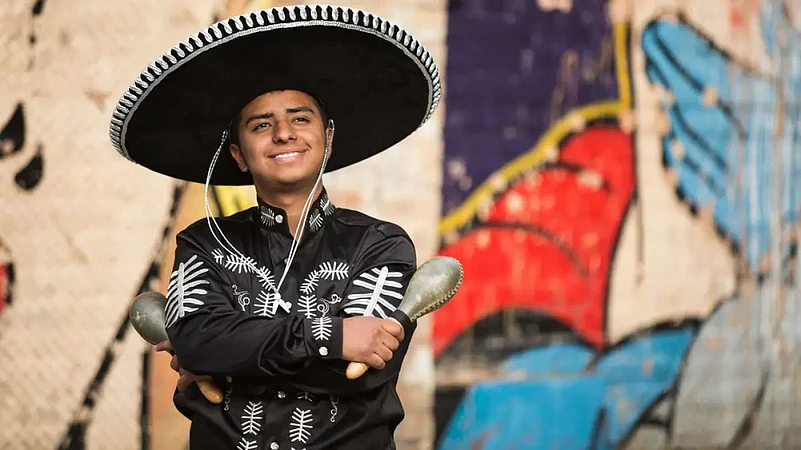Hats can have a variety of purposes; they may hold religious importance, they may signify rank, they may protect the wearer from the harsh effects of nature or they may be sported simply for style. Here’s a look at some iconic headwear from around the globe and the stories behind them, their original uses and some interesting avatars they have taken on today.
The Conical Leaf Hats of Asia

People from nations across East, South, and South-East Asia adorn these conical hats, which hold different significance, style, and legends around it. For practical purposes, these hats protected their wearers from sun or rain while working on farms, sometimes even dipping them in water so the evaporation would keep them cool. While generally made with bamboo and leaves, different countries have certain variations. In Assam, they are often colourfully decorated, in Japan, the samurai wore metal versions of it as helmets. But these hats are most central to Vietnamese culture. Nón lá (‘leaf hat’) as it is known there is surrounded by a legend where a goddess wearing such a hat came down from the heavens during a torrential downpour. The hat protected against all the rain, and the goddess even showed the locals how to grow crops before disappearing. Today, Nón lá are decorated and often have poetry stitched within. Moreover, it is considered part of Vietnam’s national dress.
The Ushanka of Russia

This fur hat with its iconic ear flaps are synonymous with Russia, and while similar hats existed across Scandinavia and the Balkans from as early as the 17th century, the Ushanka as it exists today comes from the White Army uniform during the Russian civil war.
The name Ushanka in Russian comes from the word ‘Ushi’, meaning ear and was meant to keep troops warm under extremely low temperatures, using sheepskin or rabbit fur, although modern Ushanka are often made with artificial furs, dubbed ‘fish fur.’ Today, Ushanka form part of winter uniforms for several armies, such as that of the United States and Canada, as well as the U.S. Postal Service. But the image it conjures up in everyone’s minds remains decidedly Russian.
The Red Fez of Morocco
The fez draws its name from the Morrocan city of Fez from where the dye for the hat was extracted from crimson berries. The origins of this cylindrical, felt hat are debated, with some tracing it back to ancient Greece while others believe it came from the Balkans during the Byzantine empire, subsequently being popularised by the Ottoman empire. During the Ottoman’s considerable reforms in 1826, turbans were banned in favour of the fez in an egalitarian measure to do away with age-old ideas of displaying rank and status. As a result,

The fez became an important piece of headgear in countries like Cyprus and Turkey, where it is still worn. It is even a part of the Moroccan national dress today.
The Scottish Bonnets
The Tam o’shanter is a type of flat bonnet, a hat which was popular across the United Kingdom from as early as the 17th century. In the 19th century, renowned Scottish poet Robert Burns wrote a poem entitled Tam o’shanter from where the particular Scottish iteration of the hat draws its name, adorned with a pompom or ‘toorie’ on its center. Part of standard Scottish military uniform during the First World War, the hat is still worn today as working headgear in Scotland as well as in some regiments of the Canadian Army. The Tam o’shanter acts as a loose ancestor to a variety of other hats, such as a Tam variant for women, Graduation Tams, often used when graduating with a masters degree or a doctorate, and even the Rastacap, (also known simply as ‘Tam’) worn by both Rastafari and non-Rastafari in Jamaica.
The Bowler Hat of England

English hat makers Thomas and William Bowler created this hat when tasked to make a close-fitting alternative to Top-hats which wouldn’t get knocked over by low branches while hunting game on horseback. From then on, these hard felt hats became a symbol of the working class in 19th century Britain, and later in the 20th century, became associated with ‘City Gents,’ the businessmen who worked in the financial district. They fell more or less completely out of fashion in the 1970s. Bowler were the most popular hats in the American west, contrary to popular belief. Their closer fit and small brim prevented them from flying away while on horseback and were thus worn by cowboys, outlaws, lawmen, railroad workers. Stranger still, Quechua and Aymara women in Bolivia have worn them since the 1920s when they were introduced by British Railroad workers. Named the Bombin, these hats have today spread across Bolivia and are worn by women across the country.
The Sombrero of Spain

The Spanish word sombrero, meaning hat predates this particular hat by a long shot. Being developed to protect the wearer from the sunny, iberian climes, this hat was quickly adopted by other Spanish-speaking countries such as Mexico and many Latin American countries. In Mexico, sombreros are common not only with cowboys and ‘charros’ (traditional horsemen) but also with Mariachi bands while the perform, often with even wider brims, conical crowns, and intricate decorations.
























